Harraden, Richard Bankes (McKechnie Section 2)
See also Section Seven
Recorded by Jackson (Dictionary) and Mayne as Richard Harradene; other standard authorities list the artist (correctly, as we now know) as Richard Harraden. There were two Cambridge artists of this name, father and son. In spite of the fact that the name on the trade label on a few recorded silhouettes is stated simply as 'R. Harraden', it is clear from information given to me by Mr M. Cormack (Keeper of Paintings at the Fitzwilliam Museum, Cambridge) and Mr E. Cave (City Librarian, Cambridge) that these silhouettes are the work of the son, whose full name was Richard Bankes Harraden.
Graves records that Richard Harraden the elder (1756-1838) exhibited several architectural drawings or paintings at the Royal Academy in 1799, from 2 Great Newport Street, London. (One of them, No. 892, is untitled, and, although indexed as by Harraden, is catalogued as by T. Malton). Four of these were views of Cambridge. The last, No. 938, was named 'Senate House, Public Library, and King's College Chapel, Cambridge'. I have recently found a print entitled 'King's Coll. Chapel, Public Library and Senate House, Cambridge', which is clearly inscribed 'Drawn by R. Harraden, junr. Etched by Elizabeth Byrne' and 'Published Jany lst., 1809 by R. Harraden and Son, Cambridge & by R. Gibb and Son, 288, Holborn, London'. There were several contemporary engravers and/or etchers named Byrne, including J. Byrne (1786-1847) and Letitia Byrne (1779-1849), the children of W. Byrne (1760-1805), a line engraver who was the pupil of the well known engraver William Woollett. Elizabeth may have been another daughter. As later exhibits are listed by Graves as by R. B. Harraden, it must be concluded that the 1799 exhibits were by the father, and that similar views of King's College Chapel, and other Cambridge subjects, were drawn both by father and son.
Foskett includes the information that the elder Richard Harraden was born in London in 1756 and that the family came from Flintshire, the name having originally been spelt 'Hawarden'. He spent some time in Paris, left on the taking of the Bastille, and worked as an artist in London. Foskett says that in 1798 he moved to Cambridge, where he lived at Trumpington. The 1799 Royal Academy exhibits suggest that this move in fact occurred later. Matters are complicated by Bénézit's ascription to 'R. B. Harraden' of four aquatints of views of Paris. These might, of course, have been engraved by the younger Harraden after his father's work. Foskett states that the elder Harraden published one of a series of books, Cantabrigia Depicta, in conjunction with his son, though this volume is stated by other authorities to have been the work of the younger Harraden. Long states that the elder Harraden painted miniatures and profiles, and notes a miniature by him, seen at Cambridge, and inscribed as having been painted there on 5 July 1802. Most writers agree that the elder Harraden died in 1838, although other writers have stated that this was the year in which his son died.
On available evidence it would seem that the silhouettes (and probably the portrait miniatures) were the work of R. B. Harraden, and I myself think that an artist such as his father, whose architectural work was of Royal Academy standard, would be unlikely to have taken up work in such different fields later. The standard of work shown by the silhouettes is, however, high. All the known examples represent university sitters wearing gowns, and are therefore difficult to date with accuracy. Mayne records an example (at the Victoria and Albert Museum, London) dated 1802. Two examples in my collection, and two others illustrated in Section Seven, were probably taken 1800-1810. R. B. Harraden would have been aged twenty-four in 1802, and, after lessons in drawing and painting given by his father, would by this age have been proficient enough to produce work of this standard.
1612, 1613
Little is recorded of Harraden's early years, which he probably spent first in Paris and then in London, with his parents. Graves lists under his name a total of twenty-three exhibits, most of them landscapes, sent in from Cambridge 1823-30. Harraden was a founder member of the Society of British Artists in Suffolk Street (where twenty-one of his exhibits were shown) and remained a member until 1849. Graves (The British Institution) also records two exhibits at the Institution in 1823: No. 125, Warwick Castle, and No. 131, Kenilworth Castle. That Harraden continued to work after 1849 is evident from the illustrated pencil and water-colour drawing of the market place in Cambridge, signed and dated 1853. (There are also earlier views, dated 1832 and 1834, in the Cambridge City Library). Harraden may have spent part of his career in Oxford, for not only are views of Oxford mentioned on his trade label, but he executed a large oil painting of the High Street, signed and dated 1823. We do not know, however, when the views of Oxford mentioned on the trade label were painted, and we cannot eliminate the possibility that they were the work of the artist's father.
I have seen four oil paintings by Harraden in sale-rooms. These were pairs: two painted on canvas (13¾ x 19¾ in.) entitled Whittlesford and Sidney Sussex (College), Cambridge; two painted on mahogany panels (9 x 12¾ in.) entitled Sawston Church, Cambridge and Whittlesford Church. All were signed and dated 1823, and were therefore painted in the same year as the picture of the High Street.
I have already mentioned books by Harraden. Robert Bowes (Catalogue of books printed at or relating to ... Cambridge, 1894) records 'Richard Bankes Harraden, son of Richard Harraden, B. 1778, Member of the Society of British Artists 1824-49, D. Regent Street, Cambridge, 1862' and lists Cantabrigia Depicta: a series of engravings ..., 1809, in which Harraden described and illustrated university costume. Harraden was also the author of Costume of the Various Orders in the University of Cambridge (Cambridge, 1805), which originally appeared in four numbers and contained seventeen plates in colour. (It seems likely that Harraden painted his silhouettes during the years which he spent in his study of university costume). One other book, written in 1811 and not recorded by Bowes, is History of the University of Cambridge.
The address given on the only surviving trade label is 'South Side of St. Mary's Church'. The label also mentions a statue of Sir Isaac Newton; this must be the statue made in 1755 by Roubiliac, assisted by Christian Carlsen Seest (fl. 1734-57) (Rupert Gunnis, Dictionary of British Sculptors, London, 1953). Another address, given on an undated trade card, is 6 King's Parade, but there is no mention of silhouette or miniature work on this card.
831
It is clear from the information given above that Harraden's artistic capacity was by no means confined to silhouette work, and it is to be expected that the quality of the painting of his silhouettes should be exceptionally good, as it is. The base colour of his profiles is a deep, slightly brownish, grey. The detail of clothing, and of university gowns, is skilfully depicted either by fine lines of pigment mixed with gum arabic, or by Indian ink. I am inclined to think that he used gum arabic, especially as he states on his trade label that he was a painter of miniatures (one example, probably by him, has been mentioned), and gum arabic was much used by miniaturists. Hair detail is added in the base colour with a very fine brush, and hairs are almost shown individually. Harraden drew the folds of the stock and the ruffles of the shirt-frill very carefully. The pigment is thinned where lighter patches are required for highlighting folds of material.
Harraden's profiles were usually housed in papier mâché frames of good quality. One example (illustrated) has been backed (beneath the trade label) by what appears to be part of a handbill, printed on blue paper, advertising the artist's books on the gowns and hoods of the universities.
Only one trade label (illustrated; discussed above) is known. Harraden probably signed his miniatures; when working as a drawing master he used the trade card (also illustrated, and discussed above).
Ills. 826-831, 995
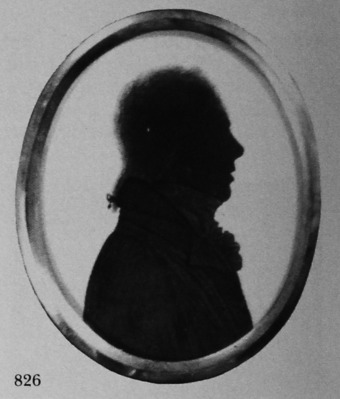
Unknown undergraduate of Cambridge University
Silhouette painted on card in shades of dark brownish grey
1800-1810
2 7/8 x 2 3/8 in./74 x 61mm.
Trade Label
Frame: papier mâché
The name of the town Grantham is written on the reverse.
Author’s collection
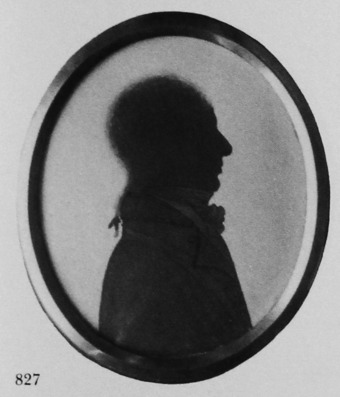
Unknown man, a member of Cambridge University
Silhouette painted on card in shades of dark brownish grey
1800-1810
2 7/8 x 2 3/8 in./74 x 61mm.
Trade Label
Frame: papier mâché
Below the trade label is a fragment of a handbill.
Author’s collection
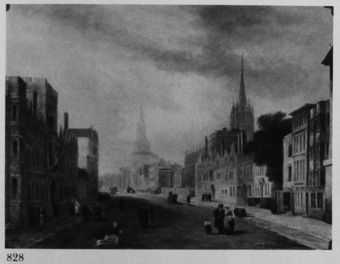
High Street, Oxford
Oil on canvas
1823
By courtesy of Richard Green Ltd
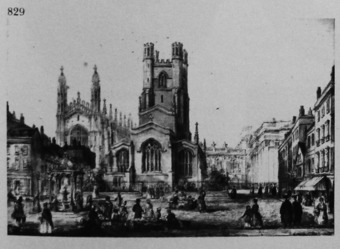
View of the market-place, Cambridge
Pencil and water-colour
1853
17 x 11 5/8 in./439 x 298mm.
Reproduced by permission of the Syndics of the Fitzwilliam Museum, Cambridge; Museum Bo. 1203
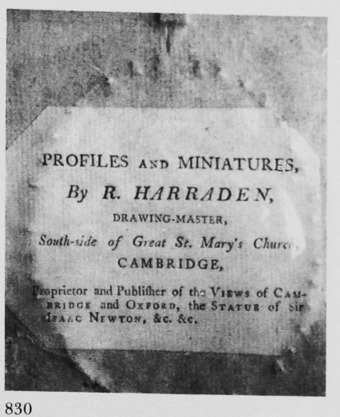
Trade label of R. B. Harraden, on which he offered his services as silhouette artist and miniaturist.
Author’s collection
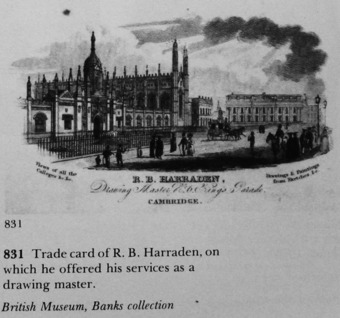
Trade card of R. B. Harraden, on which he offered his services as a drawing master.
British Museum, Banks collection
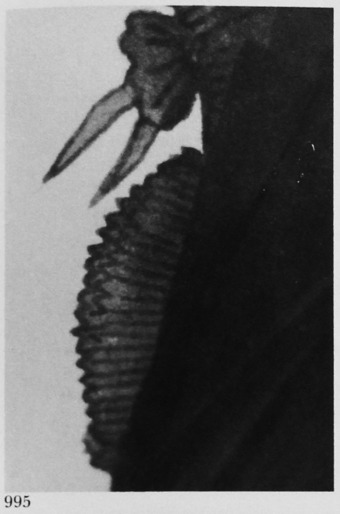
Man’s shirt-frill. Detail from a silhouette by R. B. Harraden.
